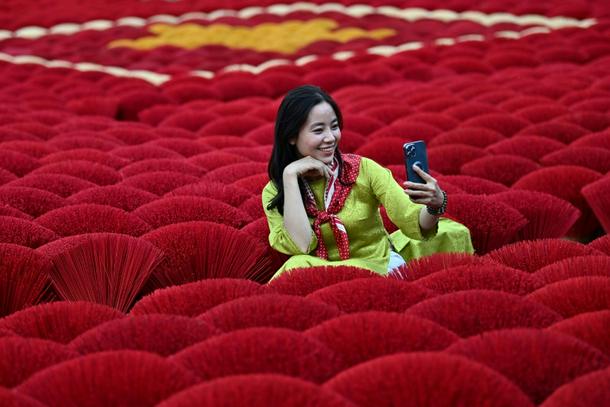Vietnam’s Incense Village Turns into Instagram Hotspot
Hanoi (AFP) – In a tiny village in northern Vietnam, Dang Thi Hoa ties up a bundle of freshly dried incense sticks ahead of Lunar New Year and watches a line of tourists waiting to pose for pictures.
Three generations of Dang Thi Hoa’s family have been dyeing incense sticks scarlet red, or magenta pink, ahead of the new year celebrations – known as Tet in Vietnam.
But Hoa, and many other families living and working in the “incense village” of Quang Phu Cau, now also make sticks in yellow, blue, and green, catering to visitors eager to snap shots for Instagram.
In front of one village temple, hundreds of bundles of multi-colored sticks were laid to dry in the sun – arranged in the form of a giant Vietnamese map.
“Our village has become a hotspot for tourists,” said Hoa, 45, who has been crafting incense sticks for three decades.
The villagers make a healthy sum from the selfie snappers.
For 50,000 VND ($2), tourists can spend as long as they like taking pictures with a workshop’s sticks – which themselves cost just 50 cents for a pack of 20.
The villagers cater to the selfie snappers, including by arranging incense in the form of a giant Vietnamese map
At a nearby home, a metal stairway has been erected to allow shots from above.
Nguyen Huu Long told AFP that he was extremely busy, with orders pouring in ahead of Tet, when worshippers gather at temples to light incense or burn sticks on ancestral altars at home.
But even at his workshop’s peak busy season, he ensures someone is available to chaperone the visitors.
“I assign one or two people to help visitors find the best angle for photos – and to make sure they don’t mess up the drying of the sticks,” Long, 58, told AFP.
The tourists seem appreciative.
“The place is very nice, very colorful, and it’s really an Instagram-worthy place,” said Catherine Caro from the Philippines.
Quang Phu Cau, on the outskirts of Hanoi, is among several villages across Vietnam involved in the ancient incense stick trade, with many families living down its small alleys involved in the dying, drying, or whittling down of the bamboo bark.
Making the incense sticks involves hacking down bamboo branches to feed into a whittling machine, dipping thin strips into buckets of dye, and then leaving them to air dry.
The full work sequence includes hacking down bamboo branches to feed into a whittling machine, dipping the thin strips into buckets of colorful dye, before leaving the sticks fanned out on the street like bouquets to air dry.
“I am proud of our family’s traditional craft… and also feel happy as our village has become more well-known,” said Hoa.
“I am also earning more,” she said, happily.
















































